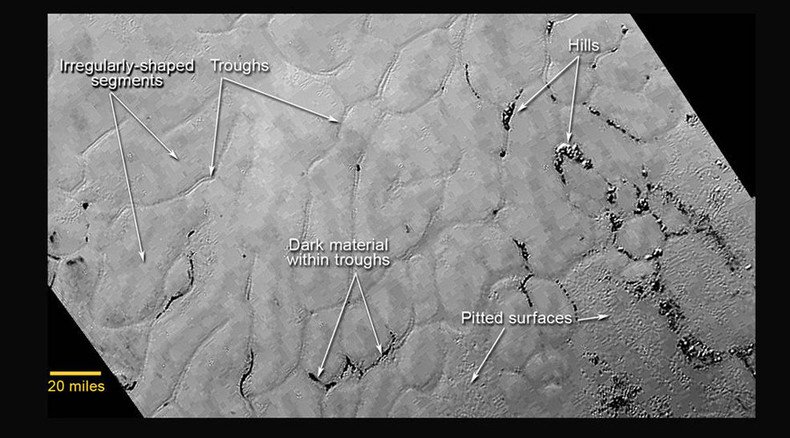Mystery terrain in Pluto’s icy ‘heart’ revealed in latest New Horizons close-up image

A frozen plain, aligned with a network of troughs filled with dark material can be seen on one of the latest photos of Pluto released by NASA. The scientists have described it as ‘not-easy-to-explain’ terrain.
The craterless plain in the picture, dubbed the Sputnik plain, after the Earth’s first artificial satellite, “appears to be no more than 100 million years old,” a NASA press release says.
It’s situated north of Pluto’s earlier detected icy mountains in the heart-shaped bright area on the dwarf planet’s surface.
READ MORE: Pluto will steal your heart: NASA exposes 'most detailed' image ever
“I’m a little biased, but I think the solar system saved the best for last,” principal researcher Alan Stern said during the Friday news conference.
The troughs in the picture are most probably filled with hydrocarbons, and some have icy hills on them, the mission scientist said.
“When you look at this plain you can see a vast, craterless plain with some strange story to tell,” Jeff Moore, a planetary scientist at the NASA Ames Research Center in Moffett Field, California, said.
“When I first saw [the plains], I called it the ‘not-easy-to-explain’ terrain,” he added.
“Pluto is every bit as geologically active as any place we’ve seen in the solar system,” the planetary scientist added.
The polygons in between the troughs are about 20 to 30 kilometers across, and Pluto might be boiling hot deep inside, with the heat causing bubbles in the ice – while another version is that the terrain is more like mud cracks on Earth.
Stern also said that the data showed a huge concentration of carbon monoxide within the heart-shaped region, and scientists still do not understand how the substance appeared there.
It “definitely catches our eye because across the rest of this disk there’s no other carbon monoxide concentration,” Stern added.
Other disclosed data concerns Pluto’s small moon, Nix, which is 40 kilometers across, and might be elongated. Images with a higher resolution, as well as stereo photos, are set to be released shortly.
“This is just a taste of what’s in the unsent data,” Moore said.












